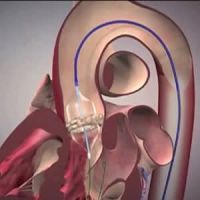New research from the University of North Carolina School of Medicine indicates that transcatheter aortic valve replacement (TAVR) was associated with shorter hospital stay and more frequent discharge to home, compared to surgical aortic valve replacement (SAVR). Also, the rate of in-hospital deaths among TAVR patients declined from 4.2 percent to 1.6 percent during the four-year study period, according to the findings published in Circulation: Cardiovascular Interventions.
SAVR has long been considered the standard of care for older adults with aortic stenosis. In recent years, TAVR has increasingly gained acceptance as a less-invasive treatment option. Researchers, led by John P. Vavalle, MD, assistant professor and medical director of the UNC Structural Heart Disease Programme, assessed how TAVR compares to SAVR when it comes to the metrics of average length of stay (LOS) in the hospital and discharge to home versus discharge to a skilled nursing facility.
The researchers analysed hospitalisations data from the National Inpatient Sample (NIS) database for more than 13,000 adults aged 50 or older who underwent either TAVR or SAVR between 2012 and 2015. They found that the average length of stay declined among both groups of patients, but there was a significantly greater reduction among TAVR patients.
In addition, Dr. Vavalle's team found that during the course of the study, the percentage of TAVR patients who were being discharged to home/home healthcare increased from 67.7 percent to 77.4 percent, the percentage of TAVR patients who were being transferred to skilled nursing facilities decreased from 27.1 percent to 20.7 percent, and the in-hospital mortality of TAVR patients decreased from 4.2 percent to 1.6 percent.
Overall, patients who underwent TAVR had a significantly shorter length of stay and were significantly less likely to be transferred to a skilled nursing facility compared to patients who underwent SAVR.
"From 2012 to 2015, there was substantial decrease in LOS and an increase in the proportion of home discharges during the same time period among patients undergoing TAVR. In addition, high-risk patients had a significantly shorter LOS when undergoing TAVR, were more likely to be discharged home, and were less likely to be discharged to a skilled nursing facility, compared to if they had undergone SAVR," the study concludes.
Source: University of North Carolina Health Care
Image Credit: UNC School of Medicine
Latest Articles
TAVR, SAVR, transcatheter aortic valve replacement, surgical aortic valve replacement
New research from the University of North Carolina School of Medicine indicates that transcatheter aortic valve replacement (TAVR) was associated with shorter hospital stay and more frequent discharge to home, compared to surgical aortic valve replacement



























